| Revision as of 08:51, 28 August 2013 view sourceBladesmulti (talk | contribs)15,638 edits →Introduction← Previous edit | Revision as of 08:54, 28 August 2013 view source Bladesmulti (talk | contribs)15,638 edits →Domestic sewageNext edit → | ||
| Line 126: | Line 126: | ||
| ] serving Boston, Massachusetts and vicinity.]] | ] serving Boston, Massachusetts and vicinity.]] | ||
| Domestic sewage is typically 99.9 percent water with 0.1 percent pollutants. Although found in low concentrations, these pollutants pose risk on a large scale. |
Domestic sewage is typically 99.9 percent water with 0.1 percent pollutants. Although found in low concentrations, these pollutants pose risk on a large scale.{{Citation needed}} In urban areas, domestic sewage is typically treated by centralized sewage treatment plants. Well-designed and operated systems (i.e., secondary treatment or better) can remove 90 percent or more of these pollutants. Some plants have additional systems to remove nutrients and pathogens. Most municipal plants are not specifically designed to treat toxic pollutants found in industrial wastewater.<ref>EPA (2004). Document No. EPA 832-R-04-001.</ref> | ||
| Cities with sanitary sewer overflows or combined sewer overflows employ one or more ] approaches to reduce discharges of untreated sewage, including: | Cities with sanitary sewer overflows or combined sewer overflows employ one or more ] approaches to reduce discharges of untreated sewage, including: | ||
Revision as of 08:54, 28 August 2013

Water pollution is the contamination of water bodies (e.g. lakes, rivers, oceans, aquifers and groundwater). Water pollution occurs when pollutants are directly or indirectly discharged into water bodies without adequate treatment to remove harmful compounds.
Water pollution affects plants and organisms living in these bodies of water. In almost all cases the effect is damaging not only to individual species and populations, but also to the natural biological communities.
Introduction

Water pollution is a major global problem which requires ongoing evaluation and revision of water resource policy at all levels (international down to individual aquifers and wells). It has been suggested that it is the leading worldwide cause of deaths and diseases, and that it accounts for the deaths of more than 14,000 people daily. Some 90% of China's cities suffer from some degree of water pollution, and nearly 500 million people lack access to safe drinking water. In addition to the acute problems of water pollution in developing countries, developed countries continue to struggle with pollution problems as well. In the most recent national report on water quality in the United States, 45 percent of assessed stream miles, 47 percent of assessed lake acres, and 32 percent of assessed bays and estuarine square miles were classified as polluted.
Water is typically referred to as polluted when it is impaired by anthropogenic contaminants and either does not support a human use, such as drinking water, and/or undergoes a marked shift in its ability to support its constituent biotic communities, such as fish. Natural phenomena such as volcanoes, algae blooms, storms, and earthquakes also cause major changes in water quality and the ecological status of water.
Categories
Surface water and groundwater have often been studied and managed as separate resources, although they are interrelated. Surface water seeps through the soil and becomes groundwater. Conversely, groundwater can also feed surface water sources. Sources of surface water pollution are generally grouped into two categories based on their origin.
Point sources
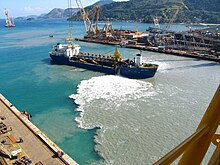
Point source water pollution refers to contaminants that enter a waterway from a single, identifiable source, such as a pipe or ditch. Examples of sources in this category include discharges from a sewage treatment plant, a factory, or a city storm drain. The U.S. Clean Water Act (CWA) defines point source for regulatory enforcement purposes. The CWA definition of point source was amended in 1987 to include municipal storm sewer systems, as well as industrial stormwater, such as from construction sites.
Nonpoint sources
Nonpoint source pollution refers to diffuse contamination that does not originate from a single discrete source. NPS pollution is often the cumulative effect of small amounts of contaminants gathered from a large area. A common example is the leaching out of nitrogen compounds from fertilized agricultural lands. Nutrient runoff in stormwater from "sheet flow" over an agricultural field or a forest are also cited as examples of NPS pollution.
Contaminated storm water washed off of parking lots, roads and highways, called urban runoff, is sometimes included under the category of NPS pollution. However, this runoff is typically channeled into storm drain systems and discharged through pipes to local surface waters, and is a point source.
Groundwater pollution
See also: Groundwater § Pollution, and HydrogeologyInteractions between groundwater and surface water are complex. Consequently, groundwater pollution, sometimes referred to as groundwater contamination, is not as easily classified as surface water pollution. By its very nature, groundwater aquifers are susceptible to contamination from sources that may not directly affect surface water bodies, and the distinction of point vs. non-point source may be irrelevant. A spill or ongoing releases of chemical or radionuclide contaminants into soil (located away from a surface water body) may not create point source or non-point source pollution, but can contaminate the aquifer below, defined as a toxin plume. The movement of the plume, called a plume front, may be analyzed through a hydrological transport model or groundwater model. Analysis of groundwater contamination may focus on the soil characteristics and site geology, hydrogeology, hydrology, and the nature of the contaminants.
Causes
The specific contaminants leading to pollution in water include a wide spectrum of chemicals, pathogens, and physical or sensory changes such as elevated temperature and discoloration. While many of the chemicals and substances that are regulated may be naturally occurring (calcium, sodium, iron, manganese, etc.) the concentration is often the key in determining what is a natural component of water, and what is a contaminant. High concentrations of naturally occurring substances can have negative impacts on aquatic flora and fauna.
Oxygen-depleting substances may be natural materials, such as plant matter (e.g. leaves and grass) as well as man-made chemicals. Other natural and anthropogenic substances may cause turbidity (cloudiness) which blocks light and disrupts plant growth, and clogs the gills of some fish species.
Many of the chemical substances are toxic. Pathogens can produce waterborne diseases in either human or animal hosts. Alteration of water's physical chemistry includes acidity (change in pH), electrical conductivity, temperature, and eutrophication. Eutrophication is an increase in the concentration of chemical nutrients in an ecosystem to an extent that increases in the primary productivity of the ecosystem. Depending on the degree of eutrophication, subsequent negative environmental effects such as anoxia (oxygen depletion) and severe reductions in water quality may occur, affecting fish and other animal populations.
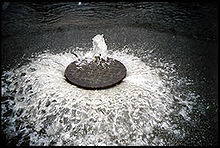
Pathogens
Coliform bacteria are a commonly used bacterial indicator of water pollution, although not an actual cause of disease. Other microorganisms sometimes found in surface waters which have caused human health problems include:
- Burkholderia pseudomallei
- Cryptosporidium parvum
- Giardia lamblia
- Salmonella
- Novovirus and other viruses
- Parasitic worms (helminths).
High levels of pathogens may result from inadequately treated sewage discharges. This can be caused by a sewage plant designed with less than secondary treatment (more typical in less-developed countries). In developed countries, older cities with aging infrastructure may have leaky sewage collection systems (pipes, pumps, valves), which can cause sanitary sewer overflows. Some cities also have combined sewers, which may discharge untreated sewage during rain storms.
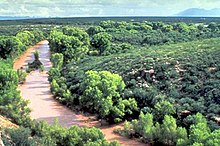
Pathogen discharges may also be caused by poorly managed livestock operations.
Chemical and other contaminants
Contaminants may include organic and inorganic substances.

Organic water pollutants include:
- Detergents
- Disinfection by-products found in chemically disinfected drinking water, such as chloroform
- Food processing waste, which can include oxygen-demanding substances, fats and grease
- Insecticides and herbicides, a huge range of organohalides and other chemical compounds
- Petroleum hydrocarbons, including fuels (gasoline, diesel fuel, jet fuels, and fuel oil) and lubricants (motor oil), and fuel combustion byproducts, from stormwater runoff
- Tree and bush debris from logging operations
- Volatile organic compounds (VOCs), such as industrial solvents, from improper storage.
- Chlorinated solvents, which are dense non-aqueous phase liquids (DNAPLs), may fall to the bottom of reservoirs, since they don't mix well with water and are denser.
- Perchlorate
- Various chemical compounds found in personal hygiene and cosmetic products.
Inorganic water pollutants include:
- Acidity caused by industrial discharges (especially sulfur dioxide from power plants)
- Ammonia from food processing waste
- Chemical waste as industrial by-products
- Fertilizers containing nutrients--nitrates and phosphates—which are found in stormwater runoff from agriculture, as well as commercial and residential use
- Heavy metals from motor vehicles (via urban stormwater runoff) and acid mine drainage
- Silt (sediment) in runoff from construction sites, logging, slash and burn practices or land clearing sites.
Macroscopic pollution—large visible items polluting the water—may be termed "floatables" in an urban stormwater context, or marine debris when found on the open seas, and can include such items as:
- Trash or garbage (e.g. paper, plastic, or food waste) discarded by people on the ground, along with accidental or intentional dumping of rubbish, that are washed by rainfall into storm drains and eventually discharged into surface waters
- Nurdles, small ubiquitous waterborne plastic pellets
- Shipwrecks, large derelict ships.

Thermal pollution
Main article: Thermal pollutionThermal pollution is the rise or fall in the temperature of a natural body of water caused by human influence. Thermal pollution, unlike chemical pollution, results in a change in the physical properties of water. A common cause of thermal pollution is the use of water as a coolant by power plants and industrial manufacturers. Elevated water temperatures decreases oxygen levels, which can kill fish, and can alter food chain composition, reduce species biodiversity, and foster invasion by new thermophilic species. Urban runoff may also elevate temperature in surface waters.
Thermal pollution can also be caused by the release of very cold water from the base of reservoirs into warmer rivers.
Transport and chemical reactions of water pollutants
See also: Marine pollutionMost water pollutants are eventually carried by rivers into the oceans. In some areas of the world the influence can be traced hundred miles from the mouth by studies using hydrology transport models. Advanced computer models such as SWMM or the DSSAM Model have been used in many locations worldwide to examine the fate of pollutants in aquatic systems. Indicator filter feeding species such as copepods have also been used to study pollutant fates in the New York Bight, for example. The highest toxin loads are not directly at the mouth of the Hudson River, but 100 kilometers south, since several days are required for incorporation into planktonic tissue. The Hudson discharge flows south along the coast due to coriolis force. Further south then are areas of oxygen depletion, caused by chemicals using up oxygen and by algae blooms, caused by excess nutrients from algal cell death and decomposition. Fish and shellfish kills have been reported, because toxins climb the food chain after small fish consume copepods, then large fish eat smaller fish, etc. Each successive step up the food chain causes a stepwise concentration of pollutants such as heavy metals (e.g. mercury) and persistent organic pollutants such as DDT. This is known as biomagnification, which is occasionally used interchangeably with bioaccumulation.
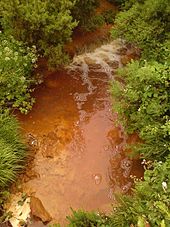
Large gyres (vortexes) in the oceans trap floating plastic debris. The North Pacific Gyre for example has collected the so-called "Great Pacific Garbage Patch" that is now estimated at 100 times the size of Texas. Many of these long-lasting pieces wind up in the stomachs of marine birds and animals. This results in obstruction of digestive pathways which leads to reduced appetite or even starvation. Many chemicals undergo reactive decay or chemically change especially over long periods of time in groundwater reservoirs. A noteworthy class of such chemicals is the chlorinated hydrocarbons such as trichloroethylene (used in industrial metal degreasing and electronics manufacturing) and tetrachloroethylene used in the dry cleaning industry (note latest advances in liquid carbon dioxide in dry cleaning that avoids all use of chemicals). Both of these chemicals, which are carcinogens themselves, undergo partial decomposition reactions, leading to new hazardous chemicals (including dichloroethylene and vinyl chloride). Groundwater pollution is much more difficult to abate than surface pollution because groundwater can move great distances through unseen aquifers. Non-porous aquifers such as clays partially purify water of bacteria by simple filtration (adsorption and absorption), dilution, and, in some cases, chemical reactions and biological activity: however, in some cases, the pollutants merely transform to soil contaminants. Groundwater that moves through cracks and caverns is not filtered and can be transported as easily as surface water. In fact, this can be aggravated by the human tendency to use natural sinkholes as dumps in areas of Karst topography. There are a variety of secondary effects stemming not from the original pollutant, but a derivative condition. An example is silt-bearing surface runoff, which can inhibit the penetration of sunlight through the water column, hampering photosynthesis in aquatic plants.
Measurement

Water pollution may be analyzed through several broad categories of methods: physical, chemical and biological. Most involve collection of samples, followed by specialized analytical tests. Some methods may be conducted in situ, without sampling, such as temperature. Government agencies and research organizations have published standardized, validated analytical test methods to facilitate the comparability of results from disparate testing events.
Sampling
Sampling of water for physical or chemical testing can be done by several methods, depending on the accuracy needed and the characteristics of the contaminant. Many contamination events are sharply restricted in time, most commonly in association with rain events. For this reason "grab" samples are often inadequate for fully quantifying contaminant levels. Scientists gathering this type of data often employ auto-sampler devices that pump increments of water at either time or discharge intervals.
Sampling for biological testing involves collection of plants and/or animals from the surface water body. Depending on the type of assessment, the organisms may be identified for biosurveys (population counts) and returned to the water body, or they may be dissected for bioassays to determine toxicity.
Further information: Water quality § Sampling and MeasurementPhysical testing
Common physical tests of water include temperature, solids concentrations (e.g., total suspended solids (TSS)) and turbidity.
Chemical testing
See also: water chemistry analysis and environmental chemistryWater samples may be examined using the principles of analytical chemistry. Many published test methods are available for both organic and inorganic compounds. Frequently used methods include pH, biochemical oxygen demand (BOD), chemical oxygen demand (COD), nutrients (nitrate and phosphorus compounds), metals (including copper, zinc, cadmium, lead and mercury), oil and grease, total petroleum hydrocarbons (TPH), and pesticides.
Biological testing
Main article: BioindicatorBiological testing involves the use of plant, animal, and/or microbial indicators to monitor the health of an aquatic ecosystem.
- For microbial testing of drinking water, see Bacteriological water analysis.
Control of pollution
Domestic sewage
Main article: Sewage treatment
Domestic sewage is typically 99.9 percent water with 0.1 percent pollutants. Although found in low concentrations, these pollutants pose risk on a large scale. In urban areas, domestic sewage is typically treated by centralized sewage treatment plants. Well-designed and operated systems (i.e., secondary treatment or better) can remove 90 percent or more of these pollutants. Some plants have additional systems to remove nutrients and pathogens. Most municipal plants are not specifically designed to treat toxic pollutants found in industrial wastewater.
Cities with sanitary sewer overflows or combined sewer overflows employ one or more engineering approaches to reduce discharges of untreated sewage, including:
- utilizing a green infrastructure approach to improve stormwater management capacity throughout the system, and reduce the hydraulic overloading of the treatment plant
- repair and replacement of leaking and malfunctioning equipment
- increasing overall hydraulic capacity of the sewage collection system (often a very expensive option).
A household or business not served by a municipal treatment plant may have an individual septic tank, which treats the wastewater on site and discharges into the soil. Alternatively, domestic wastewater may be sent to a nearby privately owned treatment system (e.g. in a rural community).
Industrial wastewater
Main article: Industrial wastewater treatment
Some industrial facilities generate ordinary domestic sewage that can be treated by municipal facilities. Industries that generate wastewater with high concentrations of conventional pollutants (e.g. oil and grease), toxic pollutants (e.g. heavy metals, volatile organic compounds) or other nonconventional pollutants such as ammonia, need specialized treatment systems. Some of these facilities can install a pre-treatment system to remove the toxic components, and then send the partially treated wastewater to the municipal system. Industries generating large volumes of wastewater typically operate their own complete on-site treatment systems.
Some industries have been successful at redesigning their manufacturing processes to reduce or eliminate pollutants, through a process called pollution prevention.
Heated water generated by power plants or manufacturing plants may be controlled with:
- cooling ponds, man-made bodies of water designed for cooling by evaporation, convection, and radiation
- cooling towers, which transfer waste heat to the atmosphere through evaporation and/or heat transfer
- cogeneration, a process where waste heat is recycled for domestic and/or industrial heating purposes.
Agricultural wastewater
Main article: Agricultural wastewater treatment
Nonpoint source controls
Sediment (loose soil) washed off fields is the largest source of agricultural pollution in the United States. Farmers may utilize erosion controls to reduce runoff flows and retain soil on their fields. Common techniques include contour plowing, crop mulching, crop rotation, planting perennial crops and installing riparian buffers.
Nutrients (nitrogen and phosphorus) are typically applied to farmland as commercial fertilizer; animal manure; or spraying of municipal or industrial wastewater (effluent) or sludge. Nutrients may also enter runoff from crop residues, irrigation water, wildlife, and atmospheric deposition. Farmers can develop and implement nutrient management plans to reduce excess application of nutrients and reduce the potential for nutrient pollution.
To minimize pesticide impacts, farmers may use Integrated Pest Management (IPM) techniques (which can include biological pest control) to maintain control over pests, reduce reliance on chemical pesticides, and protect water quality.
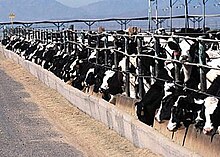
Point source wastewater treatment
Farms with large livestock and poultry operations, such as factory farms, are called concentrated animal feeding operations or feedlots in the US and are being subject to increasing government regulation. Animal slurries are usually treated by containment in anaerobic lagoons before disposal by spray or trickle application to grassland. Constructed wetlands are sometimes used to facilitate treatment of animal wastes. Some animal slurries are treated by mixing with straw and composted at high temperature to produce a bacteriologically sterile and friable manure for soil improvement.
Construction site stormwater

Sediment from construction sites is managed by installation of:
- erosion controls, such as mulching and hydroseeding, and
- sediment controls, such as sediment basins and silt fences.
Discharge of toxic chemicals such as motor fuels and concrete washout is prevented by use of:
- spill prevention and control plans, and
- specially designed containers (e.g. for concrete washout) and structures such as overflow controls and diversion berms.
Urban runoff (stormwater)
Main article: Urban runoff See also: Green infrastructure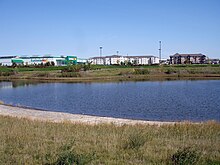
Effective control of urban runoff involves reducing the velocity and flow of stormwater, as well as reducing pollutant discharges. Local governments use a variety of stormwater management techniques to reduce the effects of urban runoff. These techniques, called best management practices (BMPs) in the U.S., may focus on water quantity control, while others focus on improving water quality, and some perform both functions.
Pollution prevention practices include low-impact development techniques, installation of green roofs and improved chemical handling (e.g. management of motor fuels & oil, fertilizers and pesticides). Runoff mitigation systems include infiltration basins, bioretention systems, constructed wetlands, retention basins and similar devices.
Thermal pollution from runoff can be controlled by stormwater management facilities that absorb the runoff or direct it into groundwater, such as bioretention systems and infiltration basins. Retention basins tend to be less effective at reducing temperature, as the water may be heated by the sun before being discharged to a receiving stream.
See also
Template:Misplaced Pages books
- Aquatic toxicology
- Cultural eutrophication
- Interprovincial Cooperatives v. The Queen (Supreme Court of Canada)
- Nutrient pollution
- Oil spill
- Paper pollution
- Peak water (water resources planning concept)
- Trophic state index (water quality indicator for lakes)
- Watershed Central
- Streeter-Phelps equation (water quality modeling tool)
References
- Pink, Daniel H. (April 19, 2006). "Investing in Tomorrow's Liquid Gold". Yahoo.
- ^ West, Larry (March 26, 2006). "World Water Day: A Billion People Worldwide Lack Safe Drinking Water". About.
- "China says water pollution so severe that cities could lack safe supplies". Chinadaily.com.cn. June 7, 2005.
- "As China Roars, Pollution Reaches Deadly Extremes". The New York Times. August 26, 2007.
- United States Environmental Protection Agency (EPA). Washington, DC. "The National Water Quality Inventory: Report to Congress for the 2002 Reporting Cycle – A Profile." October 2007. Fact Sheet No. EPA 841-F-07-003.
- ^ United States Geological Survey (USGS), Denver, CO (1998). "Ground Water and Surface Water: A Single Resource." Circular 1139.
- Clean Water Act, section 502(14), 33 U.S.C. § 1362 (14).
- CWA section 402(p), 33 U.S.C. § 1342(p)
- ^ EPA. "Protecting Water Quality from Agricultural Runoff." Fact Sheet No. EPA-841-F-05-001. March 2005.
- C. Michael Hogan (2010). "Water pollution.". Encyclopedia of Earth. Topic ed. Mark McGinley; ed. in chief C. Cleveland. National Council on Science and the Environment, Washington, DC.
- USGS. Reston, VA. "A Primer on Water Quality." FS-027-01. March 2001.
- Schueler, Thomas R. "Microbes and Urban Watersheds: Concentrations, Sources, & Pathways." Reprinted in The Practice of Watershed Protection. 2000. Center for Watershed Protection. Ellicott City, MD.
- EPA. “Illness Related to Sewage in Water.” Accessed February 20, 2009.
- ^ EPA. "Report to Congress: Impacts and Control of CSOs and SSOs." August 2004. Document No. EPA-833-R-04-001.
- ^ Stormwater Effects Handbook: A Toolbox for Watershed Managers, Scientists, and Engineers. New York: CRC/Lewis Publishers. 2001. ISBN 0-87371-924-7.
{{cite book}}: Unknown parameter|authors=ignored (help) Chapter 2. - Schueler, Thomas R. "Cars Are Leading Source of Metal Loads in California." Reprinted in The Practice of Watershed Protection. 2000. Center for Watershed Protection. Ellicott City, MD.
- Goel, P.K. (2006). Water Pollution - Causes, Effects and Control. New Delhi: New Age International. p. 179. ISBN 978-81-224-1839-2.
{{cite book}}: Cite has empty unknown parameter:|coauthors=(help) - Kennish, Michael J. (1992). Ecology of Estuaries: Anthropogenic Effects. Marine Science Series. Boca Raton, FL: CRC Press. pp. 415–17. ISBN 978-0-8493-8041-9.
{{cite book}}: Cite has empty unknown parameter:|coauthors=(help) - Laws, Edward A. (2000). Aquatic Pollution: An Introductory Text. New York: John Wiley and Sons. p. 430. ISBN 978-0-471-34875-7.
{{cite book}}: Cite has empty unknown parameter:|coauthors=(help) - For example, see Clescerl, Leonore S.(Editor), Greenberg, Arnold E.(Editor), Eaton, Andrew D. (Editor). Standard Methods for the Examination of Water and Wastewater (20th ed.) American Public Health Association, Washington, DC. ISBN 0-87553-235-7. This publication is also available on CD-ROM and online by subscription.
- ^ Newton, David (2008). Chemistry of the Environment. Checkmark Books. ISBN 0-8160-7747-9.
- EPA (2004)."Primer for Municipal Wastewater Treatment Systems." Document No. EPA 832-R-04-001.
- EPA. "Green Infrastructure Case Studies: Philadelphia." December 9, 2008.
- EPA (1997). Profile of the Fossil Fuel Electric Power Generation Industry (Report). Document No. EPA/310-R-97-007. p. 24
- ^ U.S. Natural Resources Conservation Service (NRCS). Washington, DC. "National Conservation Practice Standards." National Handbook of Conservation Practices. Accessed March 28, 2009.
- ^ EPA. "National Management Measures to Control Nonpoint Source Pollution from Agriculture." July 2003. Document No. EPA-841-B-03-004.
- EPA. "Integrated Pest Management Principles." March 13, 2008.
- EPA. "Animal Feeding Operations." December 15, 2008.
- Iowa Department of Natural Resources. Des Moines, IA. "Animal Feeding Operations in Iowa." Accessed March 5, 2009.
- Tennessee Department of Environment and Conservation. Nashville, TN."Tennessee Erosion and Sediment Control Handbook." 2002.
- EPA (2006). "Construction Site Stormwater Runoff Control." National Menu of Stormwater Best Management Practices.
- ^ EPA (1999)."Preliminary Data Summary of Urban Storm Water Best Management Practices." Chapter 5. Document No. EPA-821-R-99-012.
- EPA. "Fact Sheet: Low Impact Development and Other Green Design Strategies." October 9, 2008.
- California Stormwater Quality Association. Menlo Park, CA. "Stormwater Best Management Practice (BMP) Handbooks." 2003.
- New Jersey Department of Environmental Protection. Trenton, NJ. "New Jersey Stormwater Best Management Practices Manual." April 2004.
External links
Overview Information
- "Troubled Waters" - video from "Strange Days on Planet Earth" by National Geographic & PBS (US)
- "Issues: Water" – Guides, news and reports from US Natural Resources Defense Council
Analytical Tools and Other Specialized Resources
- Water pollution advice for businesses from the Environment Agency
- EUGRIS – portal for Soil and Water Management in Europe
- Causal Analysis/Diagnosis Decision Information System (CADDIS) - EPA guide for identifying pollution problems; stressor identification
- Ecotoxicology and Models - Eawag: Swiss Federal Institute of Aquatic Science & Technology
| Water | ||
|---|---|---|
| Overviews | ||
| States | ||
| Forms | ||
| On Earth | ||
| Extraterrestrial | ||
| Physical parameters | ||
